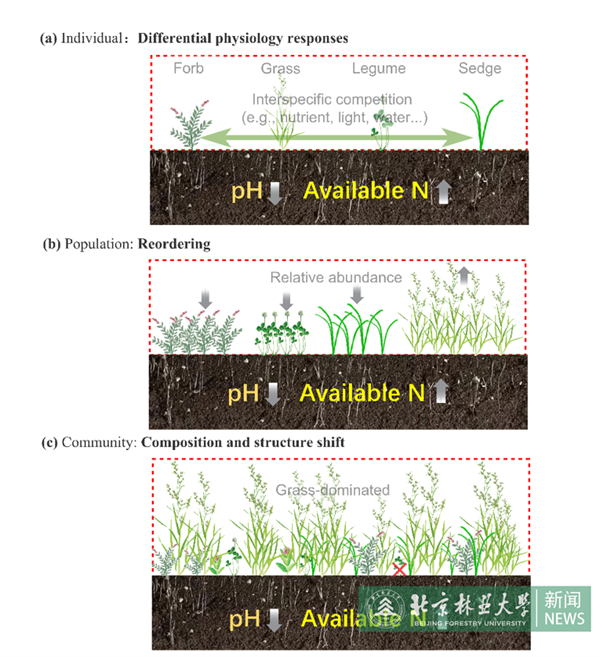Latest news
Rates of atmospheric nitrogen (N) deposition are increasing globally due to industrialization, the burning of fossil fuels, agricultural fertilization, and other human activities. By 2050, global N deposition is expected to reach 200 Tg N yr−1 , which will exceed the critical value of 100 Tg N yr−1 of the earth's N loading. In China, the rate of N deposition continues to increase by an estimated 0.41 kg ha−1 per year , although there is some evidence that the rate of N deposition in China is stabilizing. Located in Southwest China, the Qinghai-Tibetan Plateau (QTP), the highest plateau in the world, has experienced increasing rates of N deposition during recent decades, already reaching ∼10 kg N ha−1 year−1 .

Dong Shikui's research team of the School of Grassland Science found out that the intensification of nitrogen deposition changed the community structure of plants in the alpine grassland and significantly increased the dominance of grasses in their previous research "Nitrogen deposition shifts grassland communities through directly increasing dominance of graminoids: a 3-year case study from the Plus-Tibetan plateau".
In alpine grasslands, increased N deposition is increasing the dominance of grasses relative to other functional types according to our previous study Shen et al. (2022). However, the mechanisms that drive this compositional change are not fully understood. We measured the effects of 4–6 years' N addition to simulate N deposition at rates of 0 (CK), 8 (N1), 24 (N2), 40 (N3), 56 (N4), and 72 (N5) kg N ha−1 year−1 on dominant representatives of four functional types, Leymus secalinus (grass), Carex capillifolia (sedge), Potentilla multifidi (non-leguminous forb), and Medicago ruthenica (legume), in the alpine grassland on the Qinghai-Tibetan Plateau (QTP). In-situ experiment showed that N addition increased aboveground biomass in L. secalinus but had negative or neutral effects on aboveground biomass in the other species. Consistent with this finding, N addition increased net photosynthesis, chlorophyll content, and rubisco activity in L. secalinus with less positive effects on the other species. Nitrogen addition increased leaf N content in L. secalinus and C. capillifolia and reduced leaf non-structural carbohydrate content in all four species. In L. secalinus, the highest N addition rate (N5) reduced MDA content, a marker of oxidative stress, by enhancing antioxidant enzyme activity. Overall, The findings suggested that physiological factors can contribute to increased competitiveness of grass relative to sedge, forb and legume species under high N application levels. The rapid growth of this grass species reduces resource availability to non-grass species, increasing its dominance in the alpine meadow.
The research progress was published in Science of the Total Environment in the title of "Physiological factors contribute to increased competitiveness of grass relative to sedge, forb and legume species under different N application levels". Beijing Forestry University is the signature unit of the first author. The first author of the paper is Shen Hao, a youth teacher from the School of Grassland Science, and the corresponding author is Dong Shikui.
This study was funded by the National Key R&D Program of China (2021YFE0112400), the Second Tibetan Plateau Scientific Expedition and Research Program (2019QZKK0307), and the National Science Foundation of China (U20A2007-01).
Paper link: https://doi.org/10.1016/j.scitotenv.2023.167466










